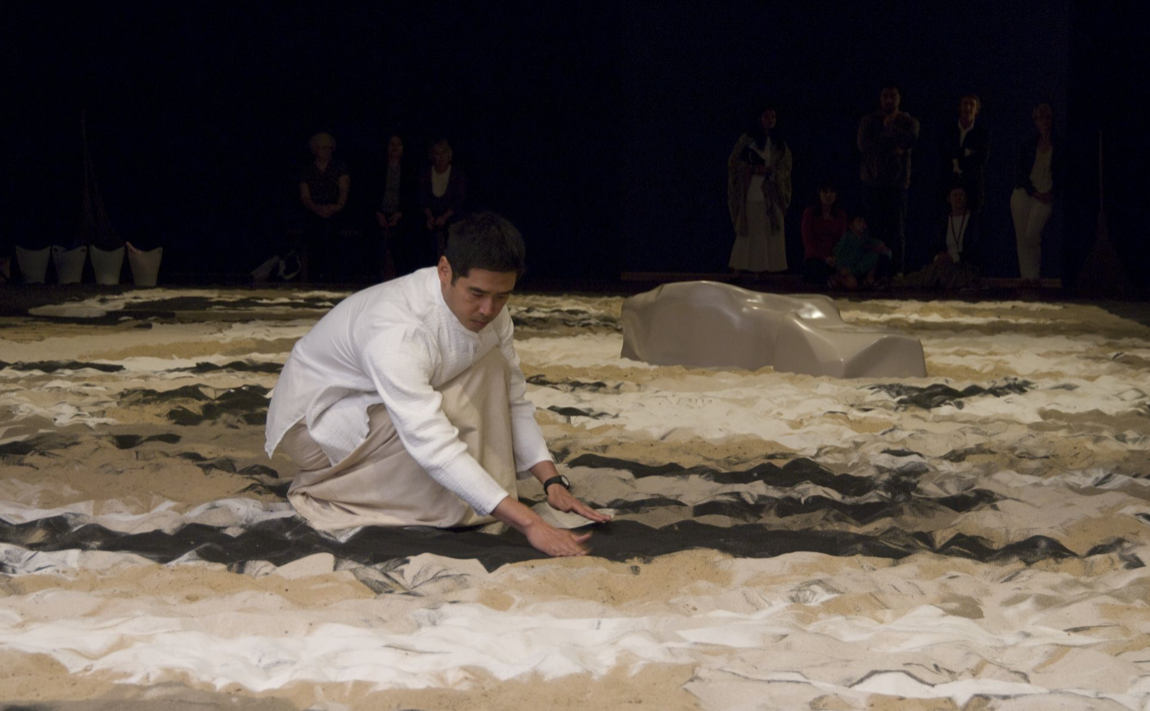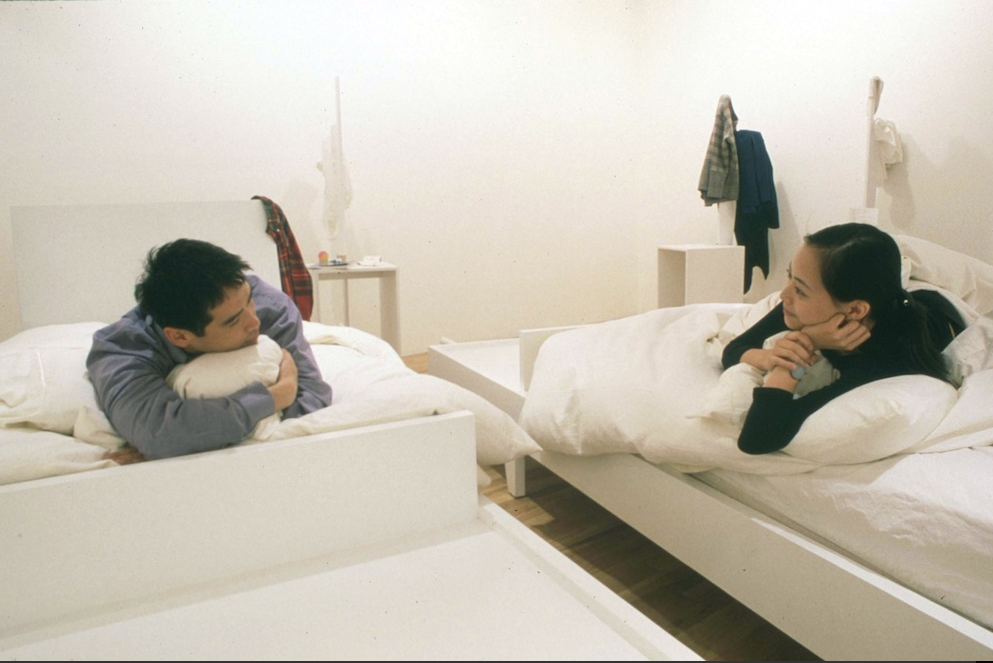
Folding and unfolding
by Victoria Thomas
The anonymous artists of classical Egypt and Greece rendered the likenesses of their gods, leaders and heroes in materials chosen to stand the test of time: marble, bronze, limestone, and pure gold. The common belief was that as long as their monuments stood, the civilization which created them would prosper.
While this is not exactly the case, their columns and perfectly muscled deities do get points for sheer staying power. But this sort of eternity is not the intent behind the work of Lee Mingwei, who creates haunting installations that self-destruct through fire, gravity, and simply the gentle passage of time. Mingwei creates mysterious art performances and experiences that explore trust, belonging, loss, loneliness, connection, gift-giving, and death. While often melancholy, his works are anything but morose. Describing his work as “ephemeral,” the Taiwan-born installation artist instead finds his meaning in folding and unfolding, between going and staying. His notions of impermanence sometimes take on flower as metaphor, as with his exhibitions Sonic Blossom, The Moving Garden, and One Hundred Days with Lily.


He takes inspiration from Octavio Paz, who wrote:
Between going and staying
the day wavers,
in love with its own transparency.
The circular afternoon is now a bay
where the world in stillness rocks.
All is visible and all elusive,
all is near and can’t be touched.
Paper, book, pencil, glass,
rest in the shade of their names.
Time throbbing in my temples repeats
the same unchanging syllable of blood.
The light turns the indifferent wall
into a ghostly theatre of reflections.
I find myself in the middle of an eye,
watching myself in its blank stare.
The moment scatters. Motionless,
I stay and go: I am a pause.
The exhibition entitled Between Going and Staying is unusual in his oeuvre in that neither the artist nor gallery-visitors interacted in any way. Instead, the piece consists of five tons of sugar-fine volcanic sand, slowly sifting down to the floor from an enormous overhead light which resembled a broken eggshell, serving as a sort of hourglass. The five tons were calculated to last approximately six weeks. When the last grains of sand reach the floor, the exhibition closes.
Another installation, Our Labyrinth, consists of a barefoot dancer dancing with a pile of rice. The black dance mat beneath the dancer’s feet suggests a pool of ink, providing contrast the ivory-golden grains that are softly brushed with a grass broom into calligraphic, swiftly changing patterns.




The artist grew up in a Ch’an Buddhist in Taiwan where he learned to appreciate the simple, transient, and everyday moments in life (Ch’an being the ancestor of Zen). The artist’s cultural background serves as the foundation for his projects which typically use the most deliberately mundane elements of human domesticity as the liminal space where humans, especially strangers, can meet and potentially encounter each other with a new openness.
Mingwei identifies Guernica in Sand as his most important creation. This three-part installation deftly summarizes the artist’s view that all of life is fleeting, Picasso’s masterpiece being a poignant portrayal of human fragility at its most vulnerable. The first phase of the installation is the creation of Guernica in colored sand. At week seven, the artist highlights the conflict between creation and destruction by inviting one museumgoer at a time to walk across the massive sand painting while he continues to work on a few final details.
Visitors continue to walk across the painting throughout the day until Mingwei stops the final participant and hands out a few twig brooms. Then, he and a few guests sweep all of the sand to the center of the space, gathering and returning the colorful grains to their place of origin in an action which seems almost Kabbala-like.
Titles for Mingwei’s installations include The Mending Project, The Dining Project, The Sleeping Project, The Moving Garden, The Letter Writing Project, and The Living Room. Gifting, specifically giving gifts to strangers, is one of the artist’s recurring motifs. For The Moving Garden, for instance, the artist distributes fresh flowers to museum attendees with this request: that they take a detour from their usual route home, and hand the flower to a total stranger.



For The Mending Project, inspired by 9/11, he invited museumgoers to bring a piece of their clothing in need of repair to the gallery, another reference that suggests the reparatory practice of Tikkun Olam to some. The artist then stitched up the garment using threads that were attached to a huge tapestry mounted on the exhibition wall, thus integrating the piece into the gallery display. The Dining Project consists of the artist cooking meals for individual strangers who enter a lottery for the experience, while The Sleeping Project is lottery-based sleepover with the artist inside the exhibition, on the museum premises.
Sonic Blossom is an ongoing participatory installation created in 2013 by Lee Mingwei for Korea’s inaugural exhibition of National Museum of Modern and Contemporary Art, and now continues to tour the world. The Sonic Blossom set consists of a chair, music stand costume and spontaneous song. During exhibition hours, operatically trained sopranos approach guests with the following question: “May I give you a gift of song?” If the museumgoer consents, the singer performs one of five chosen Lieder compositions by Franz Schubert, a cappella.
Intimate memories of family form the tent-posts for the artist’s vision. Mingwei says of the experience “Sonic Blossom came into existence while I was caring for my mother as she recuperated from surgery. We found great comfort in listening to Franz Schubert’s Lieder. These songs came as un unexpected gift to us, one that soothed us both and clearly helped her healing. One day she – and I – will be gone. Like Shubert’s Lieder, our own lives are brief, all the more beautiful because of this.” For another project called A Hundred Days With Lily, the artist carried a handful of white lilies with him for three months wherever he went, a gesture honoring his grandmother who had recently passed away.
So much of the Soolip psyche has to do with the texture of paper, and the importance of hand-written communication. The Letter Writing Project captures the essence of this by providing museum attendees with three “confessional” booths stocked with stationery, envelopes, and pencils. The booths are specified for standing, sitting, or kneeling, representing three postures of meditation in Chinese Buddhism. The booths are offered as a safe space for the participant to write a letter of gratitude, insight, forgiveness. The letters are left behind. If a letter is unsealed, other visitors are welcome to read it. If sealed and addressed, Mingwei will add a postage stamp and mail it to its intended recipient. At the end of the first exhibition, 12,000 of these letters were sent out, about one-third of them for the deceased. The unsealed letters are sometimes ritually burned.
Yearning for immortality, the desire to create something eternal, or simply the wish to be remembered defines Western art. Mingwei challenges this expectation by creating art which by definition is here, then gone in the twinkling of an eye in physical terms. His work reminds us to receive each day, each experience as a gift which, like ourselves, is only passing through. The imprint of his work may linger, perhaps for a lifetime, in the memory and sensing of a sudden act of kindness from a stranger, and the poignancy of a last petal falling from a fading bloom.
All images courtesy of Wikimedia Commons.





